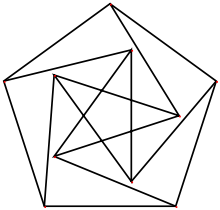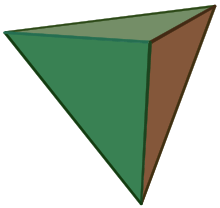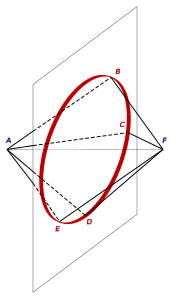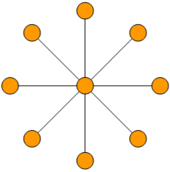Dimension (graph theory)

In mathematics, and particularly in graph theory, the dimension of a graph is the least integer  such that there exists a "classical representation" of the graph in the Euclidean space of dimension
such that there exists a "classical representation" of the graph in the Euclidean space of dimension  with all the edges having unit length.
with all the edges having unit length.
In a classical representation, the vertices must be distinct points, but the edges may cross one another.[1]
The dimension of a graph  is written:
is written:  .
.
For example, the Petersen graph can be drawn with unit edges in  , but not in
, but not in  : its dimension is therefore 2 (see the figure to the right).
: its dimension is therefore 2 (see the figure to the right).
This concept was introduced in 1965 by Paul Erdős, Frank Harary and William Tutte.[2] It generalises the concept of unit distance graph to more than 2 dimensions.
Examples

Complete graph
In the worst case, every pair of vertices is connected, giving a complete graph.
To immerse the complete graph  with all the edges having unit length, we need the Euclidean space of dimension
with all the edges having unit length, we need the Euclidean space of dimension  . For example, it takes two dimensions to immerse
. For example, it takes two dimensions to immerse  (an equilateral triangle), and three to immerse
(an equilateral triangle), and three to immerse  (a regular tetrahedron) as shown to the right.
(a regular tetrahedron) as shown to the right.
Theorem — |
In other words, the dimension of the complete graph is the same as that of the simplex having the same number of vertices.

 drawn in Euclidean 3-space.
drawn in Euclidean 3-space.Complete bipartite graphs

All star graphs  , for
, for  , have dimension 2, as shown in the figure to the left. Star graphs with
, have dimension 2, as shown in the figure to the left. Star graphs with  equal to 1 or 2 need only dimension 1.
equal to 1 or 2 need only dimension 1.
The dimension of a complete bipartite graph  , for
, for  , can be drawn as in the figure to the right, by placing
, can be drawn as in the figure to the right, by placing  vertices on a circle whose radius is less than a unit, and the other two vertices one each side of the plane of the circle, at a suitable distance from it.
vertices on a circle whose radius is less than a unit, and the other two vertices one each side of the plane of the circle, at a suitable distance from it.  has dimension 2, as it can be drawn as a unit rhombus in the plane.
has dimension 2, as it can be drawn as a unit rhombus in the plane.
Theorem — The dimension of a general complete bipartite graph Proof To show that 4-space is sufficient, as with the previous case, we use circles. Denoting the coordinates of the 4-space by We can also show that the subgraph If such a representation exists, then the three points |
To summarise:
-
 , depending on the values of
, depending on the values of  and
and  .
.
Dimension and chromatic number
Theorem — The dimension of any graph  is always less than or equal to twice its chromatic number:
is always less than or equal to twice its chromatic number:
This proof also uses circles.
We write  for the chromatic number of
for the chromatic number of  , and assign the integers
, and assign the integers  to the
to the  colours. In
colours. In  -dimensional Euclidean space, with its dimensions denoted
-dimensional Euclidean space, with its dimensions denoted  , we arrange all the vertices of colour
, we arrange all the vertices of colour  arbitrarily on the circle given by
arbitrarily on the circle given by  .
.
Then the distance from a vertex of colour  to a vertex of colour
to a vertex of colour  is given by
is given by  .
.
Euclidean dimension


The definition of the dimension of a graph given above says, of the minimal- representation:
representation:
- if two vertices of
 are connected by an edge, they must be at unit distance apart;
are connected by an edge, they must be at unit distance apart; - however, two vertices at unit distance apart are not necessarily connected by an edge.
This definition is rejected by some authors. A different definition was proposed in 1991 by Alexander Soifer, for what he termed the Euclidean dimension of a graph.[3] Previously, in 1980, Paul Erdős and Miklós Simonovits had already proposed it with the name faithful dimension.[4] By this definition, the minimal- representation is one such that two vertices of the graph are connected if and only if their representations are at distance 1.
representation is one such that two vertices of the graph are connected if and only if their representations are at distance 1.
The figures opposite show the difference between these definitions, in the case of a wheel graph having a central vertex and six peripheral vertices, with one spoke removed. Its representation in the plane allows two vertices at distance 1, but they are not connected.
We write this dimension as  . It is never less than the dimension defined as above:
. It is never less than the dimension defined as above:
Euclidean dimension and maximal degree
Paul Erdős and Miklós Simonovits proved the following result in 1980:[4]
Theorem — The Euclidean dimension of a graph  is no more than twice its maximal degree plus one:
is no more than twice its maximal degree plus one:
Computational complexity
It is NP-hard, and more specifically complete for the existential theory of the reals, to test whether the dimension or the Euclidean dimension of a given graph is at most a given value. The problem remains hard even for testing whether the dimension or Euclidean dimension is two.[5]
References
- ↑ Some mathematicians regard this strictly as an "immersion", but many graph theorists, including Erdős, Harary and Tutte, use the term "embedding".
- ↑ Erdős, P.; Harary, F.; Tutte, W. T. (1965). "On the dimension of a graph". Mathematika (12): 118–122.
- ↑ Soifer, Alexander (2009). The Mathematical Coloring Book. Springer. ISBN 978-0-387-74640-1.
- ↑ 4.0 4.1 Erdős, P.; Simonovits, M. (1980). "On the chromatic number of geometric graphs". Ars Comb. (9): 229–246.
- ↑ Schaefer, Marcus (2013), "Realizability of graphs and linkages", in Pach, János, Thirty Essays on Geometric Graph Theory, Springer, pp. 461–482, doi:10.1007/978-1-4614-0110-0_24.

 , for
, for  , is 4.
, is 4. , we arrange one set of vertices arbitrarily on the circle given by
, we arrange one set of vertices arbitrarily on the circle given by  where
where  , and the other set arbitrarily on the circle
, and the other set arbitrarily on the circle  . Then we see that the distance between any vertex in one set and any vertex in the other set is
. Then we see that the distance between any vertex in one set and any vertex in the other set is  .
. does not admit such a representation in a space of dimension less than 3:
does not admit such a representation in a space of dimension less than 3: ,
,  and
and  lie on a unit sphere with center
lie on a unit sphere with center  . Likewise, they lie on unit spheres with centers
. Likewise, they lie on unit spheres with centers  and
and  . The first two spheres must intersect in a circle, in a point, or not at all; to accommodate the three distinct points
. The first two spheres must intersect in a circle, in a point, or not at all; to accommodate the three distinct points 

